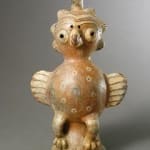Owl Effigy Ocarina, 300 BCE - 300 CE
Terracotta
11
PF.4304
Further images
Ocarinas are the musical instruments of the New World and are found in high-status tombs. This owl ocarina is very symbolic and it suggests use in rituals and ceremonies. The...
Ocarinas are the musical instruments of the New World and are found in high-status tombs. This owl ocarina is very symbolic and it suggests use in rituals and ceremonies. The owl was a very important animal to the Ancient Costa Ricans. They viewed it as an animal of wisdom and insight. The ceremonies and rituals they used this instrument for must have been highly important to the longevity and prosperity of the tribe and certain noble individuals. This owl is burnished in a brownish color with incisions of lines representing the owl's feathers. The body is also painted in beautiful designs that enhance the different patterns found on owls. The legs project off the figure and loop around onto the base, as the feet are realistically depicted showing each claw. The facial features are rendered with exactness and precision. The beak is colored in red and cream to emphasis the realism of this piece. The eyes are hollowed out and serve as the finger holes for this ocarina. This is an example of the artist ingenuity and craftsmanship. The forehead has two wavy white lines that frame the face and designate the owl’s brow. The top of the head is turned into the blowhole. Another feature that is represented is a loophole on the backside that allowed this ocarina to be suspended from the neck or the like. The tail and wings are also represented and have a three dimensional quality. Although zoomorphic vessels are not those uncommon, musical instruments with symbolic importance, such as this one, become a rarity. This unique piece encompasses these special qualities and gives us a glimpse into the culture of ritualistic and spiritual activities of the Costa Ricans.







